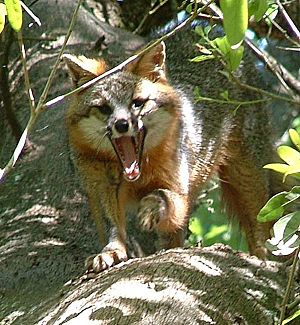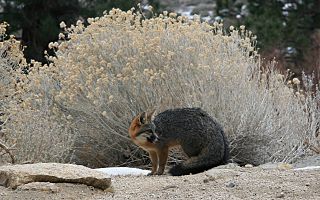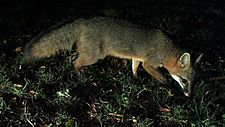Gray fox facts for kids
Quick facts for kids Gray fox |
|
|---|---|
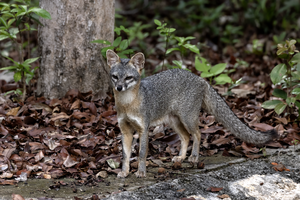 |
|
| in Tulum, Mexico | |
| Conservation status | |
| Scientific classification | |
| Genus: |
Urocyon
|
| Species: |
cinereoargenteus
|
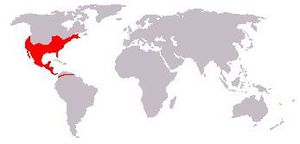 |
|
| Gray fox range | |
The gray fox (Urocyon cinereoargenteus), also called the grey fox, is a mammal that eats both plants and animals (an omnivorous animal). It belongs to the Canidae family, which includes dogs, wolves, and other foxes. You can find this fox all over North America and Central America.
The gray fox and the smaller island fox are the only living members of their group, called Urocyon. Long ago, the gray fox was the most common fox in the eastern United States. But as people built more towns and cut down forests, the red fox became more common there. However, the gray fox is still the main fox species on the Pacific States.
This amazing animal is the only fox in America that can climb trees! Its scientific name, cinereoargenteus, means "ashen silver," which describes its fur color.
Contents
What Does a Gray Fox Look Like?
The gray fox has a unique look that helps you tell it apart from other dog-like animals. Its fur on top is a mix of gray and black, giving it a "grizzled" appearance. It also has a clear black stripe running down the middle of its tail. The gray fox also has a strong neck.
These foxes are usually about 76 to 112.5 centimeters (30 to 44 inches) long, including their tail. Their tail alone can be 27.5 to 44.3 centimeters (11 to 17 inches) long. A typical gray fox weighs between 3.6 and 7 kilograms (8 to 15 pounds). Some can even weigh up to 9 kilograms (20 pounds).
You can tell a gray fox from a red fox because it doesn't have the "black stockings" that red foxes do. Also, the gray fox's tail has a black stripe, and each individual hair on its body has bands of white, gray, and black. Gray foxes have white fur on their ears, throat, chest, belly, and back legs. Unlike many other foxes, the gray fox has oval-shaped pupils in its eyes, not slit-like ones.
Where Did the Gray Fox Come From?

The gray fox first appeared in North America about 3.6 million years ago. This was during a time called the mid-Pliocene epoch. The island fox, which is a smaller relative of the gray fox, likely came from these mainland gray foxes.
Where Do Gray Foxes Live?
Gray foxes live in rocky, wooded, and brushy areas. Their home range stretches from southern Canada (like Manitoba and southeastern Quebec) all the way down to the northern parts of South America (including Venezuela and Colombia). They are not found in the mountains of the northwestern United States.
The gray fox is the only type of dog-like animal whose natural home covers both North and South America. In some places, many gray foxes live near brush-covered cliffs.
How Do Gray Foxes Behave?
One of the most special things about the gray fox is its ability to climb trees. Only a few other dog-like animals, like the Asian raccoon dog, can do this. The gray fox has strong, hooked claws that help it climb quickly. This skill helps them escape from predators like domestic dogs or coyotes. They also climb trees to find food that grows on branches.
Gray foxes can climb straight up tree trunks that have no branches, reaching heights of up to 18 meters (60 feet)! They can also jump from one branch to another. When they come down, they often jump from branch to branch or slowly climb backward, just like a domestic cat.
Gray foxes are mostly active at night (they are nocturnal) or during twilight hours (they are crepuscular, meaning active at dawn and dusk). During the day, they rest in dens they make in hollow trees, stumps, or old burrows. Some gray fox dens in trees can be as high as 9 meters (30 feet) off the ground! Before Europeans arrived in North America, red foxes mostly lived in cold northern forests, while gray foxes preferred forests with trees that lose their leaves in the fall.
Reproduction and Life Cycle
A female gray fox is pregnant for about 53 days. She usually gives birth to 1 to 7 kits (baby foxes), with an average of about 3 or 4 kits per litter. Female gray foxes can start having babies when they are around 10 months old.
When the kits are about 3 months old, they begin to hunt for food with their parents. By the time they are four months old, the kits have all their adult teeth. This means they can easily find food on their own.
Gray foxes build their dens in areas with lots of bushes or trees. Their dens are usually harder to spot than those of the red fox. They might use logs, hollow trees, rocks, burrows, or even abandoned buildings as safe places for their dens.
What Do Gray Foxes Eat?
The gray fox is an omnivorous animal, meaning it eats both meat and plants. It usually hunts alone. In the eastern U.S., it often hunts eastern cottontail rabbits. However, it will also eat small animals like voles, shrews, and birds.
In California, gray foxes mainly eat rodents (like mice and rats). They also eat lagomorphs, which are animals like jackrabbits and brush rabbits. In some parts of the Western United States, such as Zion National Park in Utah, gray foxes mostly eat insects and plants.
Fruit is a very important part of the gray fox's diet. They will eat whatever fruits are available. In general, gray foxes eat more plant material than red foxes do.
Images for kids
-
A red fox (Vulpes vulpes) confronting a gray fox at the San Joaquin Wildlife Refuge
See also
 In Spanish: Zorro gris para niños
In Spanish: Zorro gris para niños



